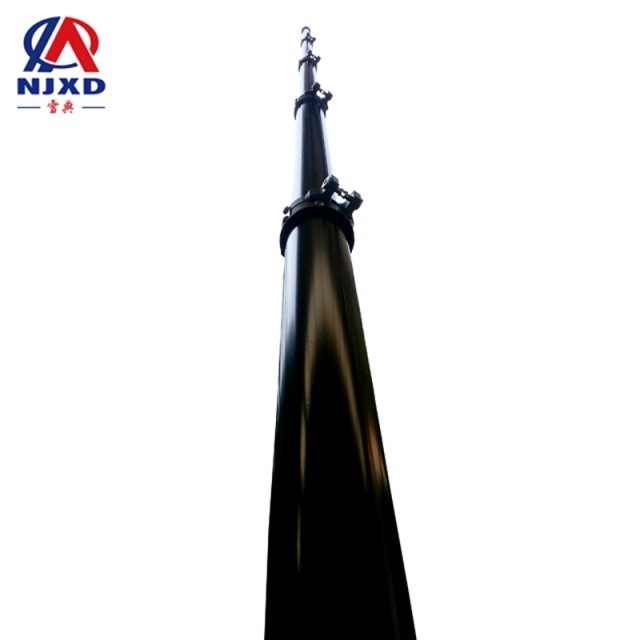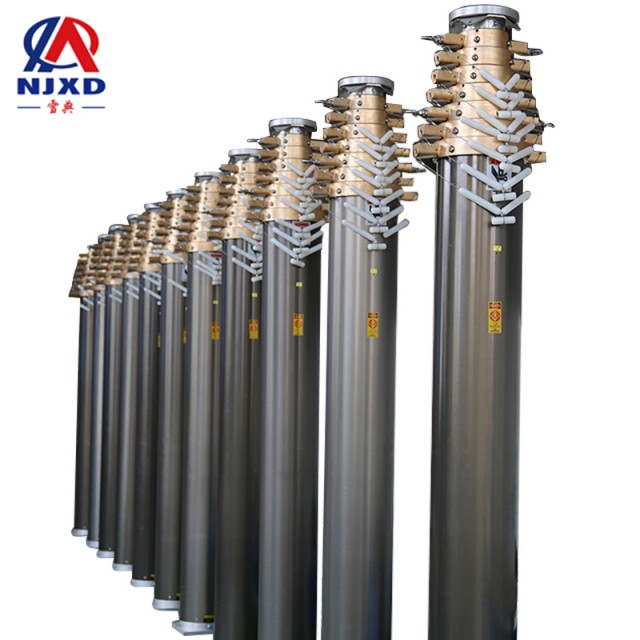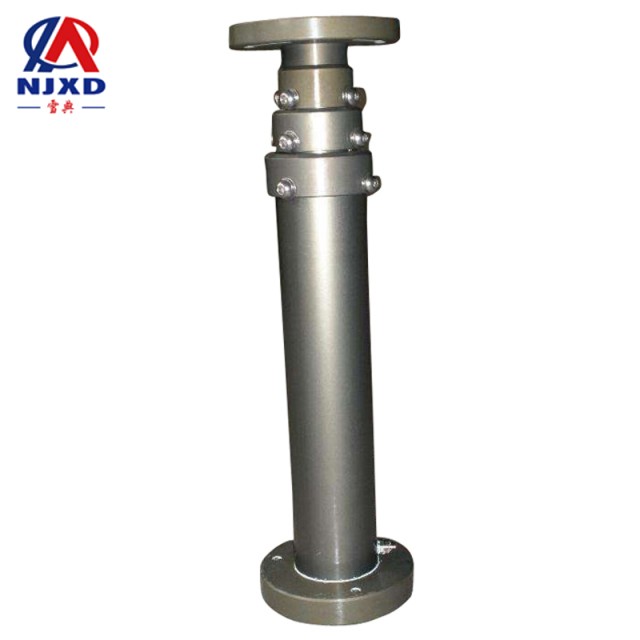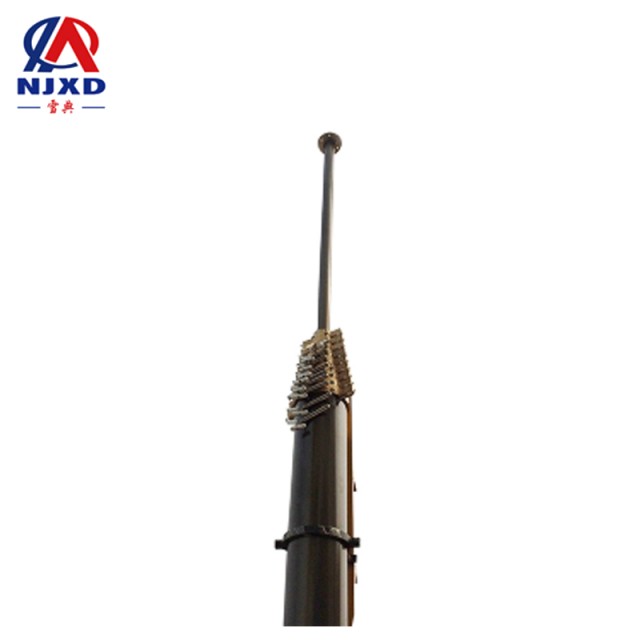NEWS
Circular section lift rod adopts feather key to prevent rotation
Time:2021-09-14 View:

The sections of circular section lift rod are connected by feather key, and the whole can prevent rotation at any height. Here, we will do some science popularization and expansion on the knowledge of feather key. It can be used in telescopic mast.
Shaft bossing
Similar to the hub, shaft bossing (shaft bossing) refers to the shaft parts connected with the shaft, common gears, pulleys, etc. The definition of shaft bossing is relatively broad, and it is generally commonly used as "shaft bossing connection.
The hub connection between the shaft and the rotating parts (such as gears, Cam, coupling, etc.) is called shaft bossing connection. The connection enables the rotating parts to be positioned and fixed on the shaft so as to transmit motion and power.
Shaft bossing connection methods include key link, integral key connection, forming connection, taper-lock connection, pin connection, set bolt connection, and over-profit connection. Some connection methods are only used for shaft bossing connection, some connection methods can be used as other connections. Keys and integral key are the most common shaft bossing connection methods.

Key joint
Key is a standard part, and key major design content is: select the type of key; Determine the size of the key; Check the strength of key joint if necessary.
Parallel key
Parallel key is used for static connection, that is, the connection between the shaft and the hub without relative axial displacement.
(1) types and characteristics
Parallel key can be divided into three types: Type A (round head), type B (square head) and C (single round head) according to different end shapes. The shaft groove of the round head key is processed by finger milling cutter. Both ends of the shaft groove have the same shape as the key, so the key is well fixed in the groove, but the stress concentration caused by the groove to the shaft is relatively large. The shaft groove of square head key is processed by disc-shaped milling cutter, and the stress concentration of the shaft is relatively small, but set Bolt is required to fix it in the key groove. Single round head key is often used in shaft end.
Parallel key transmits torque on the side, while the side is working surface, and there is a gap between the upper surface of the key and the bottom of the hub groove. Parallel key has simple structure, good centering, convenient assembly and disassembly, and easy processing, so it is widely used, but it cannot realize the shaft fixing of the parts on the shaft.
(2) size selection
The section size (b×h) of the key is selected by the standard according to the diameter d of the shaft where the key groove is located; The key length L is generally slightly smaller than the length of the part wheel hub, and must conform to the standard series of key length.
(3) strength checking
Under the action of tangential force Ft, both sides of the key and keyway are squeezed, and the a-a section of the key is cut. Therefore, the main failure mode of key joint is that the working face of weaker parts (usually hub) is crushed, and its strength conditions are as follows:
In the formula: σ p-extrusion stress, MPa;
T -- torque transmitted by Axis, N · mm;
d -- shaft diameter, mm;
h -- the height of the key, mm;
h' -- the contact height between the key and the hub, take h' ≈ h/2,mm;
-- The working length of the key, mm,A-type key: = L-b,B-type key: = L,C-type key: = L-b/2;
[Σ] p -- allowable extrusion stress MPa, see Table 1.
If one key cannot meet the strength requirements, two flat key can be adopted, and the two keys should be arranged 180 ° apart. Considering the uneven distribution of load, its strength is calculated by 1.5 keys. The key length can also be appropriately increased, but the key length should generally not exceed (1.6~1.8)d, otherwise the distribution of load along the key length is seriously uneven.
Feather key and slide key
Feather key and sliding key are used for dynamic connection, that is, the shaft and hub are connected with relative axial movement. Feather key fix it in the shaft groove with screws, and the parts on the shaft can make a small amount of axial slip along the key; For the convenience of disassembly and assembly, there is a key screw hole. The sliding key is fixed on the wheel hub, and the parts on the shaft move axially with keys; The sliding key is used in occasions where the movement amount of the parts on the shaft is relatively large. Since feather key and sliding key joint are dynamic connections, the main failure mode is the wear of the working face. The strength conditions are as follows:
In the formula: p -- pressure, MPa;
[p]-- allowable pressure, MPa.
Woodruff key
The Woodruff key is only used for static connection, and the same as flat key, it uses both sides as the working surface. The keyway on the shaft is milled out with a milling cutter of the same size as the Woodruff key, which can swing around centroid of the key in the groove to adapt to the slope of the bottom surface of the hub groove.
This kind of key connection has better centering and convenient assembly, but the keyway on the shaft is deep, which weakens the strength of the shaft greatly, and is mainly used for connection with smaller load and connection between tapered shaft end and hub. If two Woodruff keys need to be installed when the strength is insufficient, the two keys should be arranged on the same bus of the shaft so as not to weaken the strength of the shaft too much.
Wedge key and tangential key
Wedge key and tangential key are used for static connection.
The top and bottom of the wedge key are working surfaces, and the slope of the top surface of the key and the bottom surface of the hub keyway both have a taper of 1:100. After assembly, the key wedge is between shaft bossing. When working, torque is transmitted by friction between Key and shaft bossing, and it can bear axial force in one direction, but the centering accuracy is not high, which is mainly used in occasions with stable load and low speed.
The tangential key consists of two wedge keys with a slope of 1:100, the upper and lower sides (narrow surface) of which are working surfaces. One of the working surfaces passes through a plane of axial lead, the tangential action of the pressure on the working surface along the axis can transmit large-torque. When transmitting bidirectional torque, two tangential keys are needed and distributed to 120 ° ~ 130 °. Tangential key is mainly used in heavy machinery with shaft diameter greater than 100mm, tight centering requirements and heavy load.

Integral key connection
Integral key multiple key teeth are machined on the shaft, which is called integral key shaft. A number of keyways are processed on the hub hole, called integral key holes, and the connection between the two is called integral key connection. The side of the spline tooth is the working surface, and the torque is transmitted by the extrusion of the shaft and the side of the hub teeth, which can be used for dynamic connection and static connection.
Integral key due to multi teeth bearing capacity, the bearing capacity is high. It weakens the strength of the shaft lightly, has small stress concentration, high centering precision and good guiding performance, so integral key connection is often used for static connection and dynamic connection with large load and high centering precision. However, the integral key shaft and hole connected by integral key need to be processed by special equipment and tools, which is costly.
Integral key has been standardized and divided into rectangular integral key and involute integral key according to different tooth profile shapes. Rectangular integral key is most widely used due to its convenient processing. It is divided into two series: Light series and medium series, which are used for static connection with light load and medium series for static connection and dynamic connection with medium load. Rectangular integral key uses path centering. Involute integral key adopts tooth shape centering, and its processing method is the same as that of gear. There are two kinds of pressure angle: 30 ° and 45 °, which are easy to obtain higher precision. Compared with rectangular integral Key, its tooth root thickness, the tooth root has large fillet, high strength and automatic centering.

Pin connection
The pin, which is mainly used to fix the relative position between parts, is called locating pin, which is an important auxiliary part during combined processing and assembly; It can also be used for connection, which is called connecting pin, and can transmit little load; it can also be used as overload shearing element in safety device, which is called safety pin.
The material of pin generally uses carbon steel whose strength limit is not less than 500~600 MPa, such as 35 and 45 steel, and the allowable shear stress is 800 MPa.
The main types of pins are cylindrical pin, taper pin, slot pin and elastic cylindrical pin, which have been standardized except slot pin.
The cylindrical pin is fixed in the pin hole of the hinge light by using micro interference, which will damage the fastening and positioning accuracy of the connection after repeated disassembly and assembly.
Taper pin has a taper of 1:50, which can be white locked when subjected to lateral force; Fixed in the tapered hole of the hinge light by cone squeezing, the positioning accuracy is higher than that of the cylindrical pin, the positioning accuracy is less affected due to repeated disassembly and assembly. Taper pin is more widely used than cylindrical pin.
The internal thread taper pin and screw tail taper pin can be used in situations where the pin hole is not opened or it is difficult to assemble and disassemble. The opening tail taper pin can ensure that the pin will not loosen under the condition of impact, vibration or variable load.
Slot pin is a pin with a groove along the direction of the cylindrical or conical bus. It usually opens three grooves and is formed by spring steels rolling or die forging. After the slot pin presses the pin hole, its groove is compressed and deformed, therefore, it can be fixed in the pin hole by virtue of the elasticity of the material. The hole for installing the slot pin does not need precise processing. The slot pin is simple to manufacture, can be assembled and disassembled for many times, and is suitable for connection under vibration load.
Elastic cylindrical pin is a longitudinal slotted round tube made of steel belt of spring, which is evenly squeezed into the pin hole by elasticity. Pin holes do not need to be hinged. This kind of pin is lighter than solid pin and can be assembled and disassembled for many times, but because of its poor rigidity, it is not suitable for high-precision positioning.
The pin used as a connection is usually squeezed, cut and sometimes bent during work. When designing, the type, material and size of the pin can be selected first according to the structure and working requirements of the connection, and appropriate strength checking calculation can be made when necessary. A pin used as a safety device. Its size must be determined according to the condition of being cut when overload.
The locating pin is usually not subject to load or only subject to small load, and its size can be determined by experience according to the structure. The number of locating pins on the same joint surface must be at least two.

CATEGORY
NEWS
- Basic knowledge of pneumatic lifting rod sealing technology
- Circular section lift rod adopts feather key to prevent rotation
- Lift rod development direction of sealing technology
- Composition and principle of mechanical seal overview pneumatic lifting bracket
- Technical requirements and precautions of pneumatic lifting mechanical seal